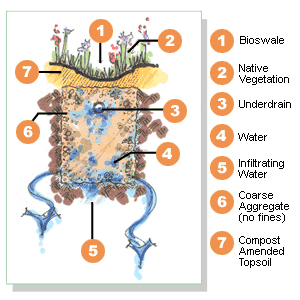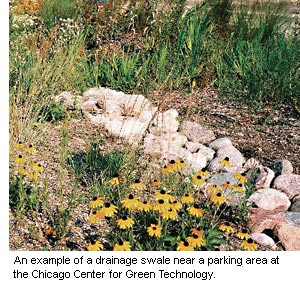Drainage Swales
 |
A swale is a broad, vegetated channel used for the movement and temporary storage of runoff. Swales also can move a portion of the runoff into the ground and filter out runoff pollutants. Drainage swales that are planted with native vegetation are commonly called bioswales. Swales can be effective alternatives to enclosed storm sewers and lined channels, where their only function is to rapidly move runoff from a developed site. On some sites, natural drainage courses may still be present and it is recommended that they be retained as part of the site drainage plan. Drainage swales are different from filter strips in that swales are primarily used for conveying water.
In contrast to conventional curb-and-gutter/storm sewer systems, swales can reduce both the rate and volume of stormwater runoff on a site. Since this is achieved via absorption of runoff into the soil, swales in sandy soils will be much more effective than swales in clay soils. Swales are most effective in reducing runoff volumes for small storm events and on an annual basis can reduce storm runoff volumes by up to 15 percent in clay soils.
Pollutant removal rates in swales are highly variable depending on the condition of the swale, particularly its slope, soils and vegetation. |
Estimated removal rates range from 30 percent to 70 percent of suspended solids and metals (such as cadmium and lead) and 10 percent to 30 percent of nutrients (such as phosphorus and nitrogen), biochemical oxygen demand and other organic compounds. As discussed earlier, soluble inorganic compounds (most notably road salt) generally cannot be removed in the soil and will eventually migrate downstream or into deep groundwater.
Swales can provide limited wildlife habitat when planted with native vegetation. Preserving existing drainageways on a development site also protects aquatic habitat.
Applicability
Drainage swales are applicable on virtually all development sites. In dense urban settings swales generally will be used in conjunction with storm sewers, rather that in lieu of storm sewers. Suggested applications include: office campus, commercial, industrial, multi-family residential, parking lots, residential parkways and highway drainage (where right-of-way widths are adequate). One type of swale is a depressed median – a recessed, landscaped area within paved surfaces. Depressed medians can be used as an alternative to raised parking lot islands, allowing water to flow into them from the surrounding pavement. Using vegetation is important in order to filter contaminants that may enter the median from the surrounding pavement.
Maintenance Considerations
Drainage swales may require periodic cleaning but this cost should be minimized if upstream sources of sediment, particularly from construction activities, are well controlled. In comparison, storm sewer catch basins need to be cleaned periodically and manholes, storm sewer pipes, and curbs will need occasional repair.
Another maintenance issue sometimes raised for swales is ponding water and the potential to breed mosquitoes. This can be avoided by providing adequate slopes and/or underdraining to avoid ponding.
|
Alternatively, the swale can be vegetated with wetland plants that can aid in the evaporation of water and provide habitat for mosquito predators such as dragonflies.
Cost Considerations
Local Examples |
 |
